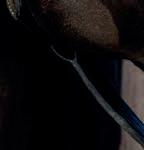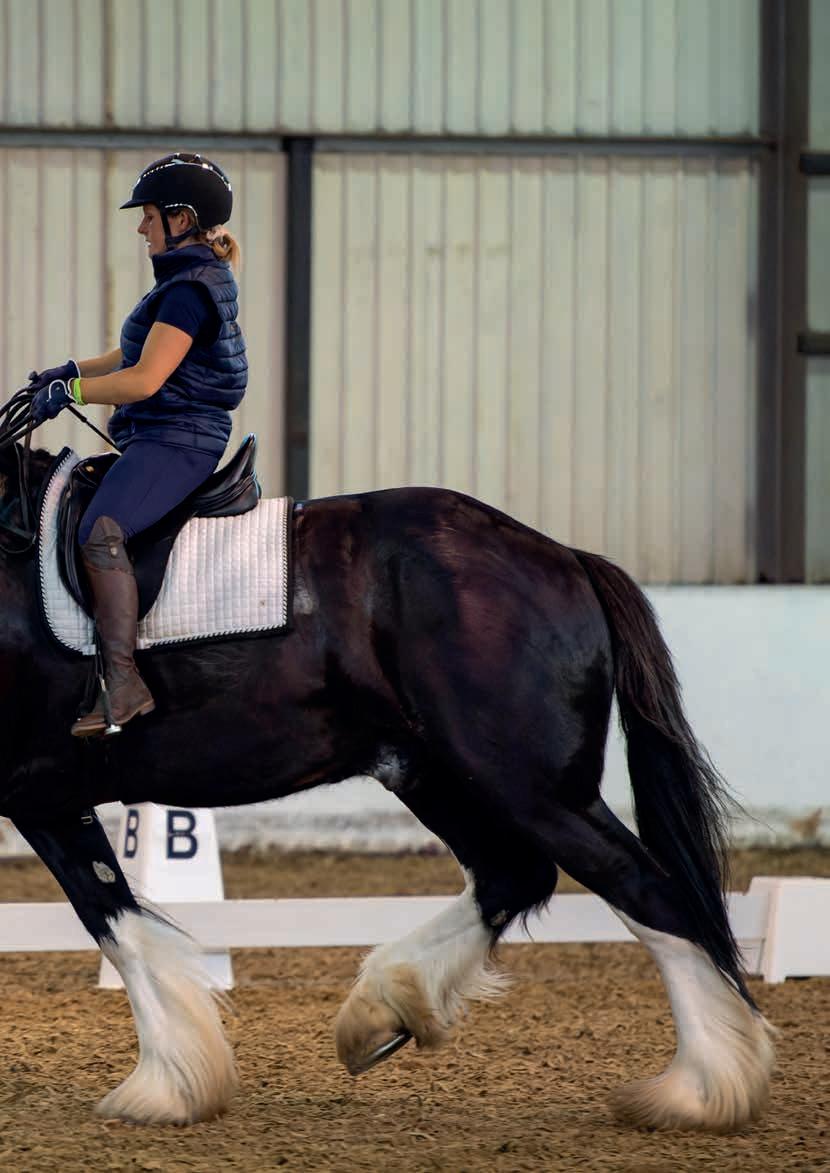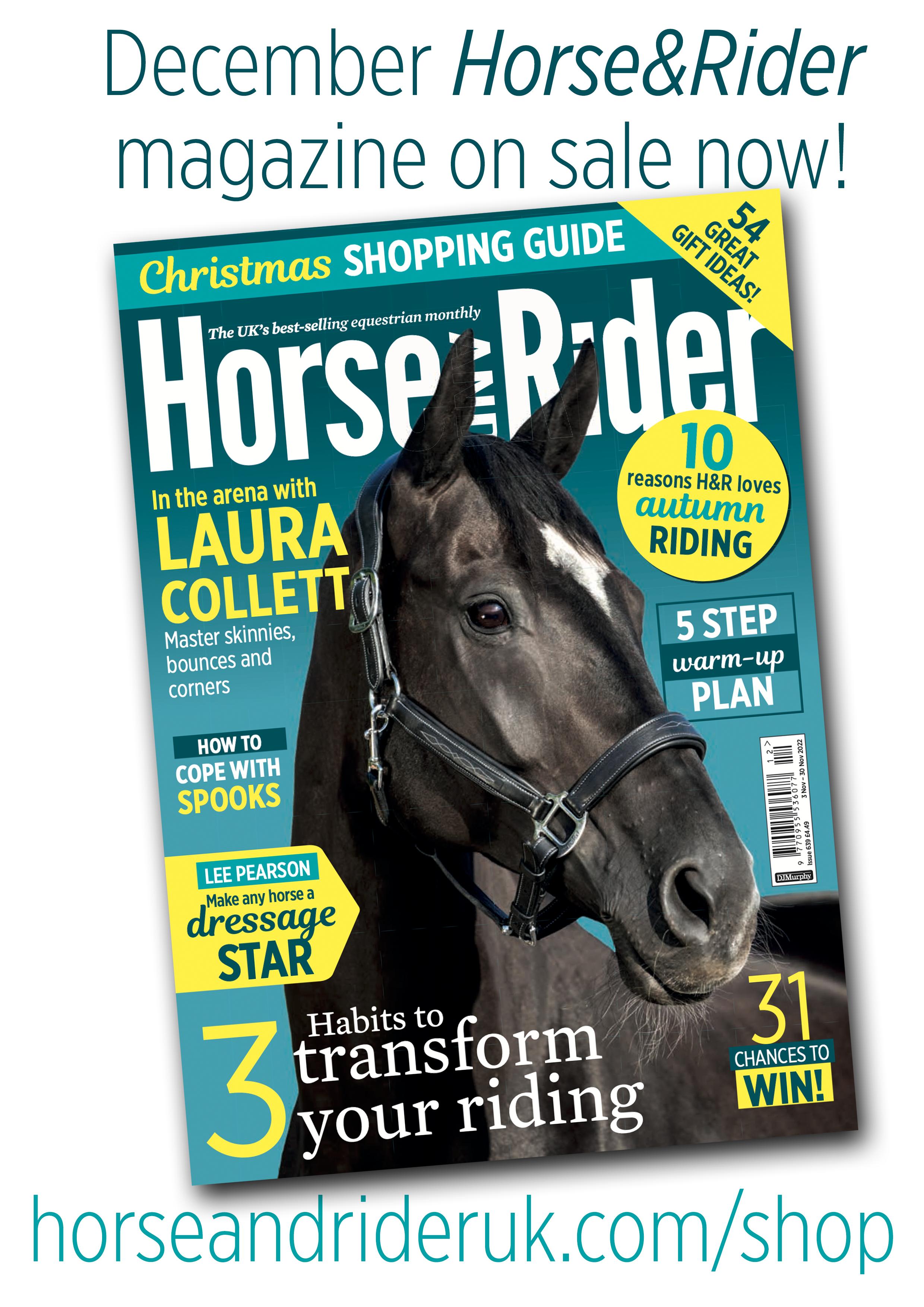


































































































Get your horse’s cross-country technique down to a tee before taking him out on grass next spring. Olympic eventer Laura Collett shows you how



Theo -season’s often viewed as an opportunity for eventers to improve their dressage and showjumping skills before being able to get back onto grass for natural fences come spring. But, there’s no reason why you can’t make the most of your arena to improve your horse’s cross-country abilities, too.
So much of a horse’s aptitude for cross-country comes from practising

focused flatwork, polework and gymnastic exercises, but there are technical fences you’ll fi nd on course that are worth perfecting on a surface fi rst. By working on these fence types in the arena, you can introduce and progress them in a controlled and confidence-building environment before taking your horse out on grass where the adrenaline, even when schooling, is higher. Let’s take a look at three of the types you’re most likely to come across.
For this, you’ll need…
• two pairs of wings
• four standard-length poles

• fillers (optional)
Bounces are beneficial additions to your jumping and gymnastic work but you may come across them on the cross-country course, so it’s important your horse has seen them beforehand.



To introduce your horse to bounces…
1. Set up the bounce as poles on the ground and ask your horse to tackle



Laura Collett has been a regular on the Team GB roster since her gold medal-winning pony days. Most recently, she became an Olympic team gold medallist at Tokyo 2020 and won the Badminton Horse Trials title in 2022.

Moonlight Charmer is a nine-year-old gelding who’s half-brother to 2019 Burghley winner, MGH Grafton Street. With Laura, he’s won five national classes, come second in Burgham’s CCI2* and third at Houghton CCI3*.
Bounces are great for improving a horse’s reactions, but they also help a rider to stay with their horse’s movement and maintain their own balance.


them in a forward, balanced canter. The distance might be a little longer than he’s used to for canter poles but it shouldn’t be unachievable. Be sure to adjust the distance if he’s struggling.

2. Raise the second pole into a cross-pole or small upright. You could approach in trot or canter, but remember to focus on maintaining your horse’s rhythm. If you approach in trot, he might pop into canter over the fi rst pole, so keep your hands soft and encouraging to allow him forward.
3. When he’s confidently popping over the pole to the fence, you can raise the fi rst pole into a cross-pole. Approach in a positive canter to help him make light of the distance and e ectively bounce between the two. If the distance is a stretch for him at fi rst, shorten it slightly, then gradually bring it back out again.


4. The next stage is to raise the jumps into small uprights. Again, start with the second one, before raising the height of the fi rst.
3.5m
C
H E K
M B F
this feature.
In the third and final part of Sir Lee Pearson’s series, he talks us through training Jupiter, a Shire who’s proven that all breeds and types can excel in dressage
Themost important quality for any dressage horse to possess is a good, trainable temperament. So even if your horse isn’t a conventional dressage type, the best starting point is a willingness to learn.
Then, regardless of his size or stature, there are qualities you can focus on within his training that will improve his suitability and help him achieve the top marks – namely balance, suppleness and activity.
Big beautiful& As told to Nicky Mo att. Photos: Jon StroudIn this feature I’ll discuss the various exercises I use to help develop these skills. They’re useful for progressing any horse’s training, whether or not he has a natural inclination for dressage. Here’s how you can get started.

Sir Lee Pearson is a 14-times Paralympic Games gold medallist. Based in Sta ordshire, he’s represented Great Britain in Sydney, Athens, Beijing, London, Rio and Tokyo.

Izzy Green is a BHS Professional Accredited Coach who trains with Lee. She coaches horses and riders in all disciplines and has her own equine breeding programme. Here, she rides Roughcote Jupiter, her eight-year-old Shire gelding.



Improve his hindleg activity Create a more supple horse
Fizz Marshall shares training insights to help you move to the next stage with your second-career Thoroughbred
So,you’ve cracked the basics of groundwork and hacking with your ex-racehorse, what happens now? Here’s how to take the next steps in your retraining programme...
Every horse learns at a di erent rate, and their response to new experiences is completely individual to them. One of the best things about ex-racehorses, however, is that they tend to be like a sponge when they come out of training. This means they generally learn quickly and respond well to new things.
During his previous career, your ex-racehorse would likely have been exposed to all sorts of stimuli, from crowds to loudspeakers, and visiting all manner of di erent racecourses. Now’s the time to build on this experience and push his boundaries a bit further.
Aim to give him an all-round education, especially if you think you might like to do a bit of everything together rather than focusing on a single discipline.
If your horse is ready, it might be at this stage that you start boxing him up and taking him away from home – for example, heading o hacking in di erent places or going cross-country schooling.
If you’re not quite there yet, build his confidence in more familiar surroundings before progressing to the next step.
 Photos: Jon Stroud
Photos: Jon Stroud
In this feature. . . Build your horse’s confidence in new situationsPhotos: Jon Stroud
Fizz Marshall has worked with all types of horses in her six years as Centre Manager at the Equine Therapy Centre at Hartpury College in Gloucestershire. More recently she’s managed racehorses for Jonjo O’Neill and been Yard Manager for Carl Hester.


One of the best things about ex-racehorses is that they tend to be like a sponge when they come out of training
